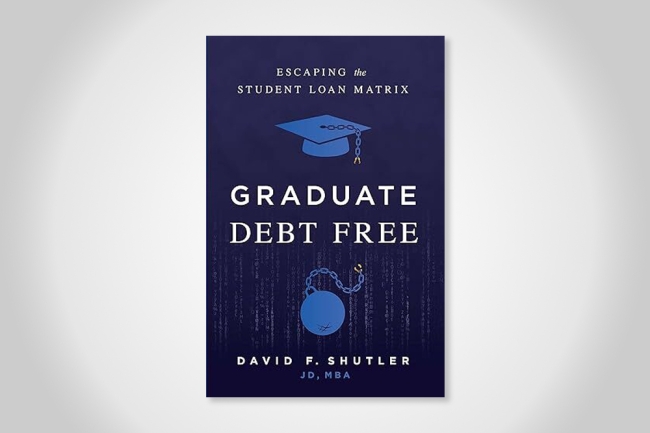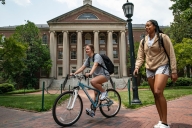You have /5 articles left.
Sign up for a free account or log in.

Dave Shutler says his new book, the product of years of research, will help students graduate with minimal debt.
Greenleaf Book Group
Students are trapped in a matrix of assumptions that lead them to take out loans for college that they won’t be able to pay back, a lawyer–turned–student loan researcher argues in a new book.
Dave Shutler, who wrote Graduate Debt Free: Escaping the Student Loan Matrix (Greenleaf Book Group Press), is a father of three adult sons, a lawyer and business owner. He spent years researching student debt, trying to figure out why the price of college was increasing and how students can get a postsecondary education without saddling themselves with more debt that they can afford to repay.
He distilled the findings in the book, which outlines a set of 12 assumptions that Shutler argues are flawed, drive students into unaffordable debt and make up the “Student Loan Matrix,” a metaphor inspired by the Matrix movie series. Students can free themselves from this matrix by challenging the assumptions, which include thinking you need a college degree to be successful, you can get an athletic scholarship and you can get a job to cover the debt.
“As you become familiar with them, you will begin to notice as the assumptions arise in your thought, and you will be prepared to challenge those assumptions,” he writes in the book’s introduction. “Like Neo, you will be able to discern if the bullet headed your way is only harmless zeroes and ones.”
Mark Kantrowitz, an expert on student financial aid and paying for college, gave the book his stamp of approval, writing in the foreword that Shutler’s book can help unravel the dilemma of student debt.
“We need new approaches about how to sensitize students and parents to college costs and education debt so that they don’t fall into a student debt trap,” Kantrowitz writes.
Shutler started looking into the issue of student debt after sending three sons to college from 1998 to 2010—St. John’s College in Santa Fe, N.M.; Brown University in Rhode Island; and New York University—and seeing the annual sticker prices increase from $35,000 to $45,000 to $55,000 with each child. His youngest son attended NYU, one of the more expensive institutions in the country. The average tuition at a private nonprofit four-year institution increased by about 81 percent over those 12 years, according to College Board data. In the 2009–10 academic year, the average tuition was $26,273.
“Even as a ‘certified smart guy’ with two professional degrees, I did not notice that student debt had been weaving a web around my family until after our third son was out of college,” he writes. “Frankly, I felt like a fool for having missed the signals.”
Shutler is hoping Graduate Debt Free will help other families make more informed decisions about a potential college education.
Shutler spoke with Inside Higher Ed over the phone about his new book, the assumptions families are making and how high school students can avoid debt. Excerpts of the conversation follow, edited for length and clarity.
Q: Your book is structured around a series of 12 assumptions about college and student debt. Are they all created equal, or does one assumption have a greater impact?
A: I think the one that keeps people down is the idea that they can’t get a scholarship. There are hundreds of scholarship sites. Thousands of scholarships available—$3.2 billion goes unawarded in grants from the feds every year because people don’t fill out the [Free Application for Federal Student Aid]. The second one is that tuition is the total cost of college. The third one is the athletic scholarship. When you get to the bottom line, your prospect of a high school [athlete] getting an athletic scholarship at a college is half of 1 percent—one out of 200.
That means you’re a big shot in high school, you’re the big man on campus and you say you’re gonna go get an athletic scholarship at some university. To do that, the simple fact is that you have to be the best in your sport in your position and in your state to do that—the best—to have a shot.
Q: Why did you want to approach this issue through the lens of a matrix and the different assumptions students and families hold about college?
A: It took shape in my mind along the lines of the movie The Matrix, where [the main character] was in a separate reality. And in time, 12 lines create a cube, and that’s the cube, and so I began to think in terms of thinking inside the box or outside the box, and I began to see these different flawed assumptions and how they affect students. Some of them aren’t so flawed, like networking … The networking that matters is not peer networking in college, as you’re talking to your buddies at the coffee shop. It’s the professors.
It’s important for students who do go to college to take advantage of faculty office hours and alumni visits. Talking to your friends over coffee, probably less important. You aren’t going to find a lot of Bill Gateses hanging around campus. But you’ve got so many opportunities when you have a professor who you talk to and they are interested in you. You can say, “Hey, you have any assistantships or anything like that?” and you begin to develop a connection. Those professors have hundreds of connections and may be able to guide students very well.
Q: How would that help them get out of college debt-free?
A: I have a caveat: you may not be debt-free, but you may be [in] minimal debt.
I do a whole section on when you are underpaid after graduating. There’s a whole study about people who graduate from college and, five years later, they’re flipping hamburgers, and they just have the debt. So the idea is that rather than being underemployed when you graduate, be appropriately employed in your field and that will help you actually pay off the debt.
I have a rule of thumb that says you should accumulate no more debt than your projected first-year salary.
What’s amazing to me is you can get the answer to that question. You can go to the Department of Education website and ask, “What does an anthropology major at Oberlin College make in their first year out of college?” And there’s 10 years of data to back it up. So you can say, “OK, I’ll make $50,000 if I follow this career path; that means I can accumulate no more debt than $12,500 a year. Therefore, when I graduate, I’ll have $50,000, and then within 10 years, I can pay it off.”
The title is supposed to be eye-catching, but the book itself has a great deal of nuts-and-bolts research on how you can actually do it with the hand that you’re dealt. Not everybody can do it debt-free. But the hand that you’re dealt typically is you have got to take on debt. When you do, this rule of thumb is very helpful. Knowing what you’ll make at the end of your academic career allows you to gauge backwards to what you can afford.
Q: You don’t have any background in education policy or higher education, right? What did the research for this book look like?
A: I am an autodidact. I just found it fascinating. I read hundreds of articles and dozens of books. I couldn’t not do it. I simply was impelled. I have a construction business. I have a private candy bar business—I make candy bars as morale boosters for our GIs overseas.
Q: You wrote about how your experience with your sons’ college educations motivated your research and this book. Knowing what you know now, what would you have done differently?
A: Man, we had no idea. By happy coincidence, I had saved for college. We had a pretty extensive college preparation fund, so the older two had a little debt. And the youngest one did not because he skipped his second semester senior year, saved that $25,000, paid it in against his debt and graduated debt-free.
[Looking back], we would not have sent him to NYU. We would’ve done something different. It ended up being $250,000. A good education, but he works as a production assistant in Brooklyn, for which he requires none of his NYU education.
That’s part of the motivation. I looked at our third son and thought, “We didn’t serve him very well.” As parents, we needed to have taken more time with him and say, what do you really want to do? What he really wanted to do is work with his hands … Part of the conversation I wish we had with our son is “Hey, what do you really want to do?”
It was my own ego. I wanted the kid to go to a name school, and so he did.
Q: How do you see this book fitting into the current national conversation about student loan debt and pathways to forgiveness?
A: This effort is two-pronged. The first prong is for the high school student to be aware and avoid it in the first place. For the college students, look at your expenses, look at how you’re doing this and rethink the proposition. For the graduate who has already got the debt, I need to write a second book, because there are some avenues. But that’s hard, because you’ve already got the debt.
In the last few chapters, there’s a lot of stuff about policy in there that talks about how it can be changed … The big rule that’s problematic is PLUS loans, because they’re uncapped. So people can go in and get an uncapped PLUS loan with no collateral and no capacity to repay. Well, that shouldn’t be. That’s a dangerous thing, particularly for people who are, let’s say, unsophisticated. They don’t know what they’re getting into, and suddenly they’re in it.
So there was an effort to do that, and Congress is currently looking at it again, and that will begin to do it.
We’re talking about $1.7 trillion. To visualize that, in my book I show a graphic of a football field covered with $100 bills stacked 10.6 feet high. It’s a gargantuan issue, and so I just take that as it is, and I say, I’m not going to change that. But I can warn students, and I can give them a ton of tools to help them not enter that debt pool.








